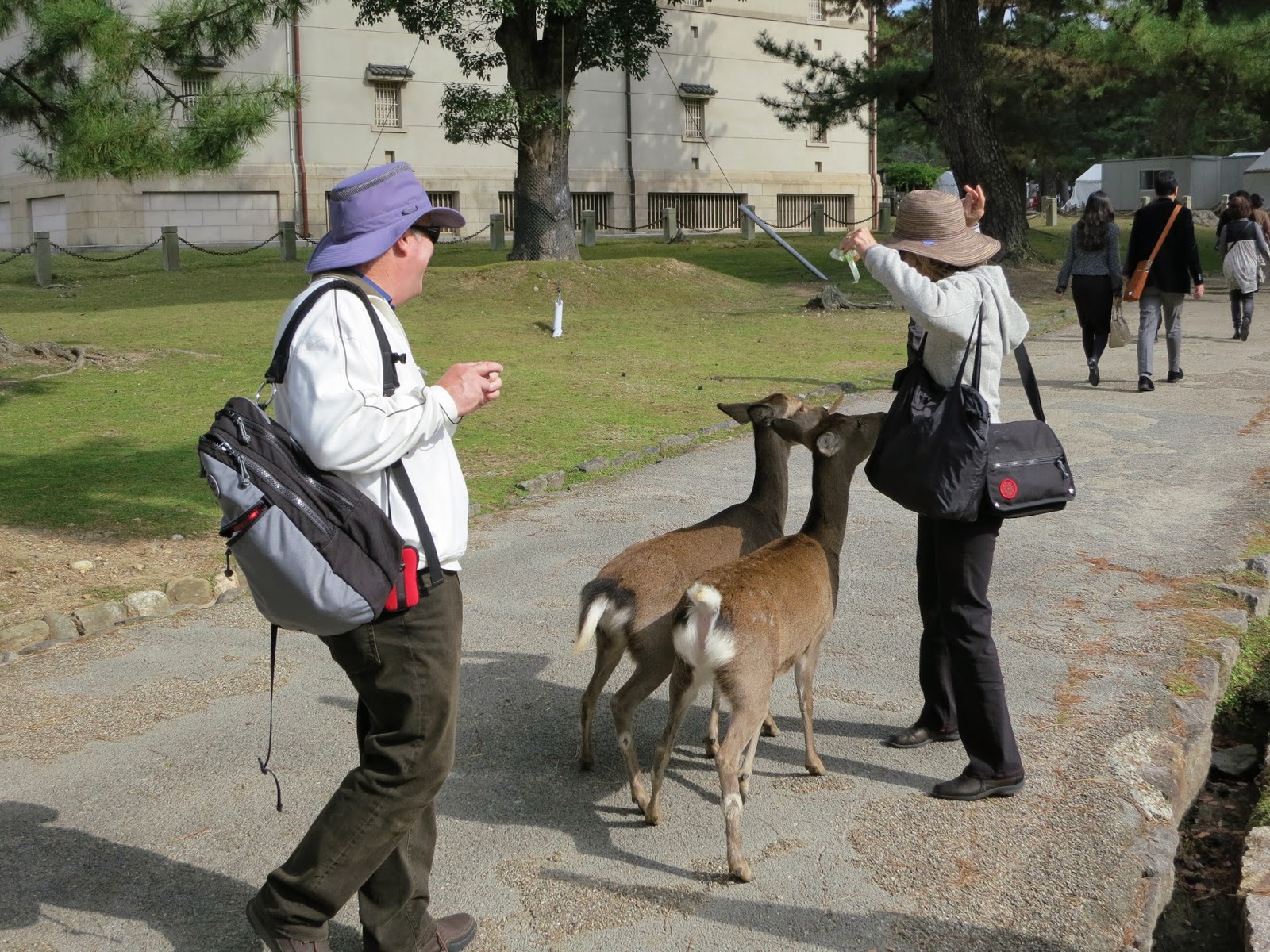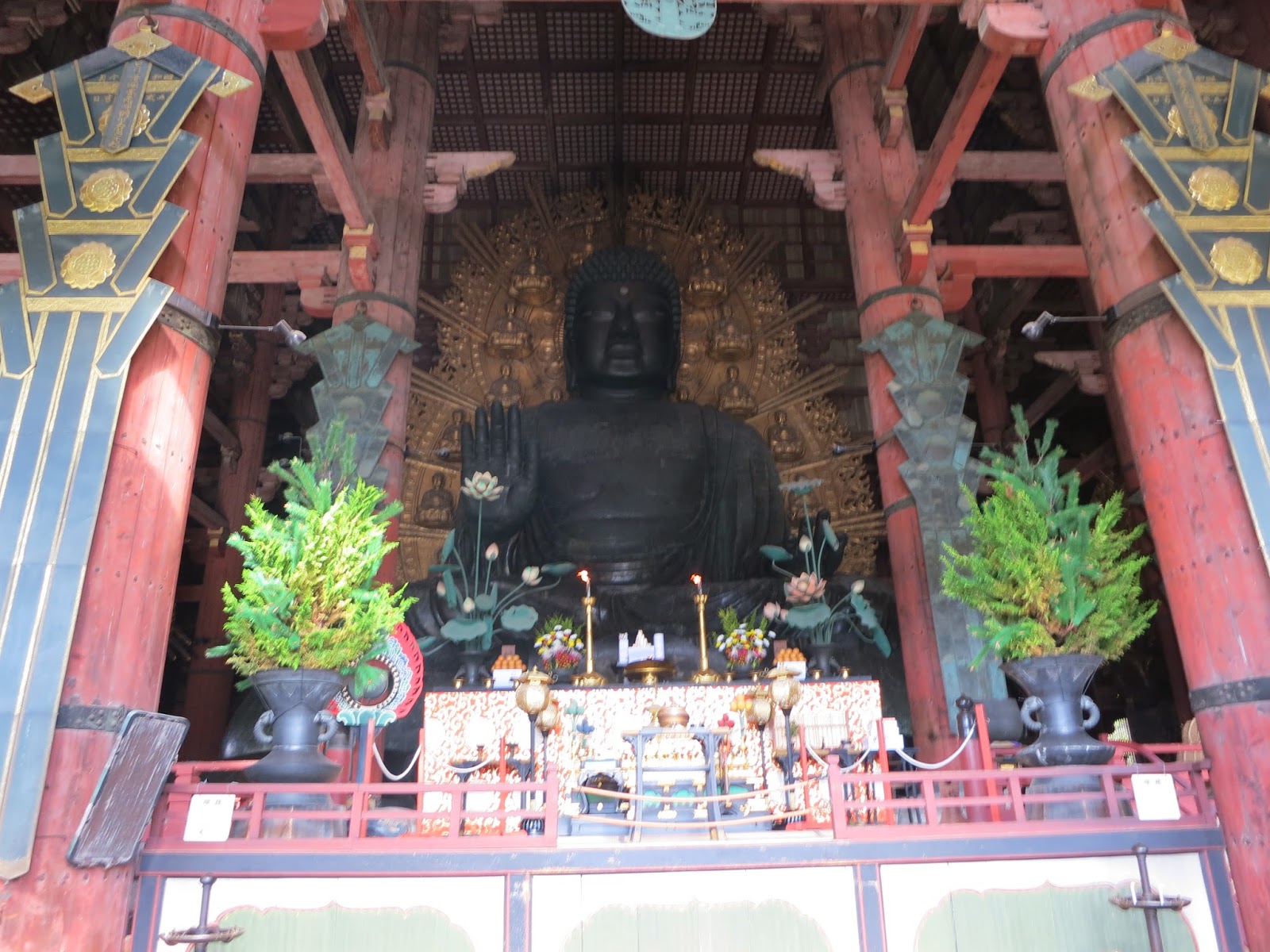The city of Nara is perhaps the
most ancient capital of Japan, located about 20-30 minutes away by a speedy JR
train from Kyoto. Nara is known for two
things, its magnificent parks/temples and its deer. I knew this before going, and I wanted to see
both so we planned a specific day trip just to Nara to see what we could. At the time I only had one goal in mind, to
see Todaiji Temple, the largest wooden structure in the world which houses
perhaps the largest bronze Buddha in Japan.
Getting to Nara was the easiest
thing we were able to do while going anywhere in Kyoto since it was a JR train
directly from Kyoto Station. The ride
was swift and smooth, and we had a nice breakfast at the hotel and planned to
find lunch while we were out. When we
were arrived, I was rather surprised.
Much of the ancient capital is now huge park in the city.
The contrast between the ancient
and the modern in Japan is night and day.
You can in one moment be in the busiest place with the most crowded tall
buildings and neon lights and sounds.
Then the next, you are surrounded by trees and green and ancient wooden
places that look as they did perhaps a millennia ago. We came to mark this passage always by the
torii gates that border the line between spiritual and real in Japan. Whenever we passed under one, we knew we had left
our world behind and entered into this more ancient one.
We entered into the park, and there standing
before us was our first deer. Beyond him
were yet more and more, standing and chomping on the grass or sitting peacefully.
First glance of the deer of Nara.
Now, I’m used to deer in the
United States. Our deer bolt the instant
they see me coming a mile away. Our
deer are also huge, or seem like it from afar.
These deer were small. Most only came up to my waist. What was more, they were perfectly tame. You could walk within inches and they
wouldn’t bat an eye. The story goes that
an ancient deity of the city rode down to defend it on the back of a deer. Since then, the creatures have been sacred
throughout Japan but most especially Nara.
They’ve become a symbol of the city, and to harm one is not only against
the law, it is a very severe taboo.
What’s more, someone took to feeding
them, and the deer have since become tame.
Notice the keen interest in what the man has in his hand.
This little guy was nosing at me just after I took this picture.
Here and there in the park are stalls selling what are known as “deer cookies.” For a nominal fee, a few hundred yen, you
get a little stack of cookies that you can feed the deer. Not a
few yards back from entering the park is a sign that shows deer kicking,
headbutting, biting etc. Most people ignore the sign and just see the
cute little deer staring at them with their big black eyes.
"FEED ME!"
Grown men become frightened children.
Naturally we did the same,
ignoring the sign and walked right up to buy cookies. Now remember what I said earlier, someone tamed the deer. I would argue
that the deer have trained the humans No sooner did we have the cookies than every one of their heads came up, and
they sauntered right over. They make
sounds. They poke and prod, and it's just so odd that you stand there
baffled. All the while, another one is
coming up behind you, and to your surprise, is extremely strong and butts you a
bit in the back of the butt as if to say, “Hey, what about me?”
This was the scene when my mom bought her "deer cookies:
It’s incredibly
fun, and worth doing, but I would say to go prepared. Get your cookies early, before you venture
deeper into the park because the further you go the more deer there are. For good reason, because this is where the
majority of tourists are and thus the majority of deer cookie vendors. How the vendors fend off the deer, I don’t
know, but they sit and watch with what seems a sense of glee at others' misfortunes.
We scurried past the deer to Todaiji Temple one of
the largest and most magnificent buildings I have ever seen. Looking at the building, I could see a distinct
Chinese influence, not unlikely considering the Nara court was influenced by
the imperial court of China.
Todaiji Temple
Ornamental lantern close up.
I took this as a size comparison of people to building.
Todaiji Temple is immense on the
outside, but it has a strangely immense feeling on the inside as well. Walking right up to it, one passes beneath a
huge door that must be three stories tall, and beyond in the darkness is a huge
Buddha. He is easily three or four times their size. Each of the leaves of the lotus he sits on
are about as tall as I and three times as wide.
Upon the leaves are emblazoned images of Buddha’s life, I assume. The Buddha himself sits in a state of gentle
repose with fingers spread in one hand and the other at rest.
The great Buddha greets you as soon as you enter with his reverent gaze.
The great Buddha is surrounded by smaller golden versions of himself on a giant golden wheel.
This is part of one of the petals of the lotus he sits on. It's easily as big as a person.
Getting close to it, one finds dozens of images of Buddha and sutra detailed in gold leaf INSIDE the bronze leaf itself.
It is his face that is the most
remarkable thing, of the many remarkable things. No matter the direction you stand in, the
eyes seem to look at you with a strange tranquil energy. You feel that the great spirit of the
Master is in this place, in a state of watchful peace.
Fearsome though he may seem, this wooden guardian is a ward against evil nature and not meant to harm people.
This is a model of the earliest construction of the temple and was much larger than the original.
We stayed quite a while in
reflection of the Buddha of Nara. What
was amazing to me was that the structure that houses him used to be much much
bigger. As with everything, there’s a
model of the current structure, and one in the past that was burned down.
I was amazed how close I could get.
A bit of Engrish here. We found this endlessly amusing. The misspelling is likely due to problems between translations.
This is one of the big highlights of our trip. A group of students stopped and paused to practice their English with my mom. They had set questions, and were extremely polite, ending the session with giving her a paper crane. They couldn't have been older than freshmen in high school. I had a similar experience later, but this was our first encounter with students, and it made us feel all the more welcome and unique.
We headed back to the station and had a very
nice lunch at an almost western style restaurant called the Suizerita
Café. It was clean and the food was
good, delivered with a push of a button on the table. We were much relieved to find they had steaks
and potatoes and “real food” we’d found so rare in the country. After
that, it was another quick train ride back to Kyoto, but our journey was not
done! Stay tuned for part 2!
























